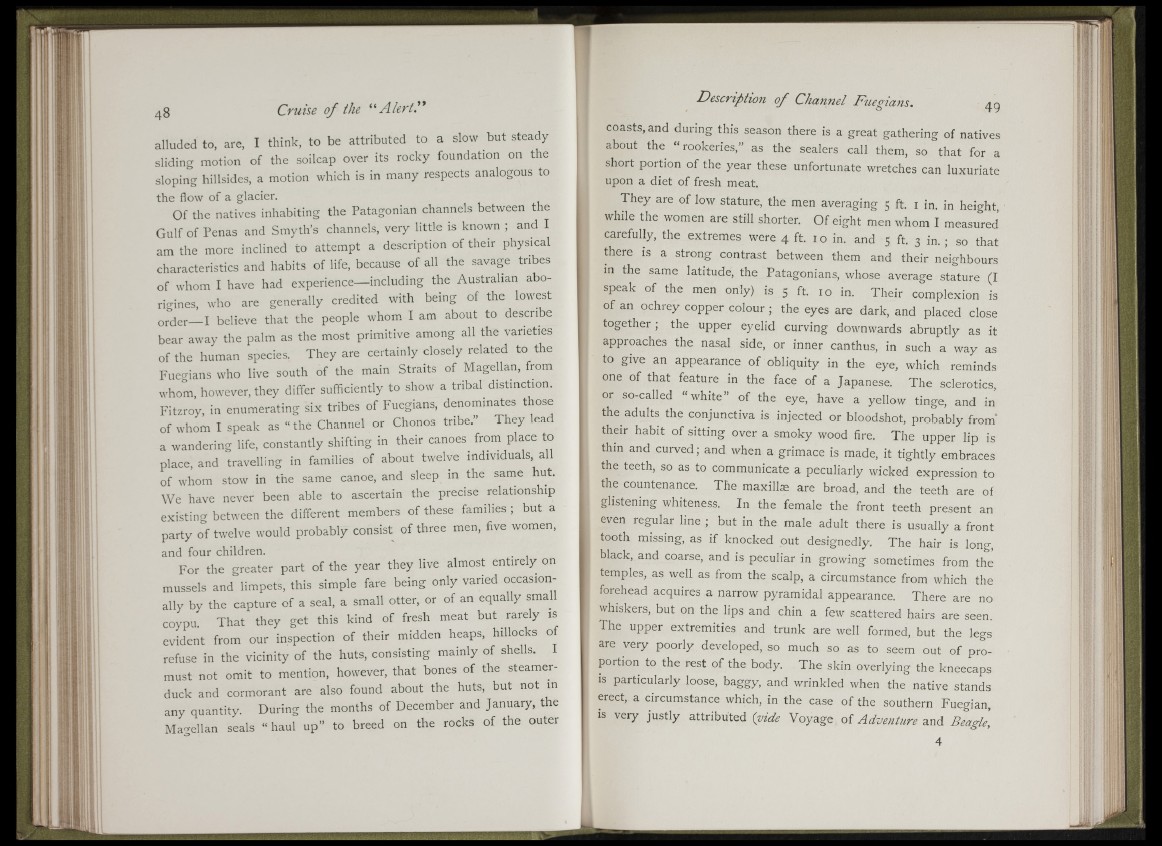
iSSka
48 Cruise of the “ Alert,”
alluded to, are, I think, to be attributed to a slow but steady
sliding motion of the soilcap over its rocky foundation on the
sloping hillsides, a motion which is in many respects analogous to
the flow of a glacier.
Of the natives inhabiting the Patagonian channels between the
Gulf of Penas and Smyth’s channels, very little is known ; and I
am the more inclined to attempt a description of their physical
characteristics and habits of life, because of all the savage tribes
of whom I have had experience— including the Australian aborigines,
who are generally credited with being of the lowest
order— I believe that the people whom I am about to describe
bear away the palm as the most primitive among all the varieties
of the human species. They are certainly closely related to the
Fuegians who live south of the main Straits of Magellan, from
whom however, they differ sufficiently to show a tribal distinction.
Fitzroy, in enumerating six tribes of Fuegians, denominates those
of whom I speak as “ the Channel or Chonos tribe.” They lead
a wandering life, constantly shifting in their canoes from place to
place, and travelling in families of about twelve individuals all
of whom stow in the same canoe, and sleep m the same ut.
We have never been able to ascertain the precise relationship
existing between the different members of these families ; but a
party of twelve would probably consist of three men, five women,
and four children.
For the greater part of the year they live almost entirely on
mussels and limpets, this simple fare being only varied occasionally
by the capture of a seal, a small otter, or of an equally small
coypu. That they get this kind of fresh meat but rarely is
evident from our inspection of their midden heaps, hillocks of
refuse in the vicinity of the huts, consisting mainly of shells. I
must not omit to mention, however, that bones of the steamer-
duck and cormorant are also found about the huts, but not in
any quantity. During the months of December and January, the
Magellan seals “ haul up” to breed on the rocks of the outer
Description o f Channel Fuegians. qg
coasts, and during this season there is a great gathering of natives
about the “ rookeries,” as the sealers call them, so that for a
short portion of the year these unfortunate wretches can luxuriate
upon a diet of fresh meat.
They are of low stature, the men averaging 5 ft. i in. in height,
while the women are still shorter. Of eight men whom I measured
carefully, the extremes were 4 ft. 10 in. and 5 ft. 3 in. ; so that
ffiere is a strong contrast between them and their ndghbours
in the same latitude, the Patagonians, whose average stature (I
speak of the men only) is 5 ft. 10 in. Their complexion is
of an ochrey copper colour ; the eyes are dark, and placed close
together ; the upper eyelid curving downwards abruptly as it
approaches the nasal side, or inner canthus, in such a way as
to give an appearance of obliquity in the eye, which reminds
one of that feature in the face of a Japanese. The sclerotics,
or so-called “ white” of the eye, have a yellow tinge, and in
the adults the conjunctiva is injected or bloodshot, probably from'
their habit of sitting over a smoky wood fire. The upper lip is
thin and curved; and when a grimace is made, it tightly embraces
the teeth, so as to communicate a peculiarly wicked expression to
the countenance. The maxillie are broad, and the teeth are of
glistening whiteness. In the female the front teeth present an
even regular line ; but in the male adult there is usually a front
tooth missing, as if knocked out designedly. The hair is long,
black, and coarse, and is peculiar in growing sometimes from the
temples, as well as from the scalp, a circumstance from which the
forehead acquires a narrow pyramidal appearance. There are no
whiskers, but on the lips and chin a few scattered hairs are seen.
The upper extremities and trunk are well formed, but the legs
are very poorly developed, so much so as to seem out of proportion
to the rest of the body. The skin overlying the kneecaps
IS particularly loose, baggy, and wrinkled when the native stands
erect, a circumstance which, in the case of the southern Fuegian,
is very justly attributed f id e Voyage of Adventure and Beagle,
4
fiio
.«I
iitf!